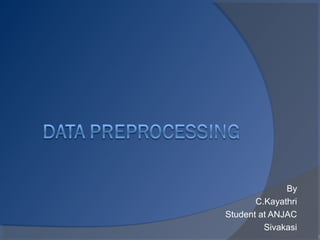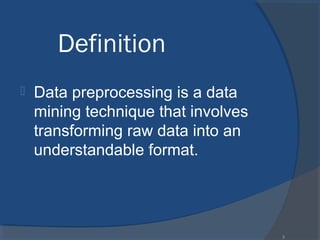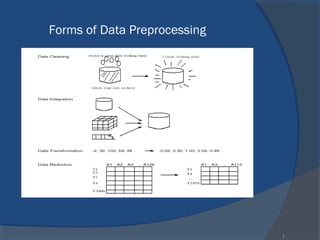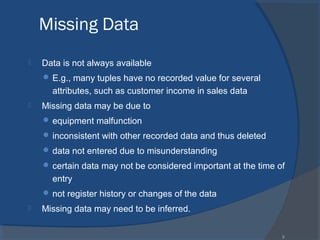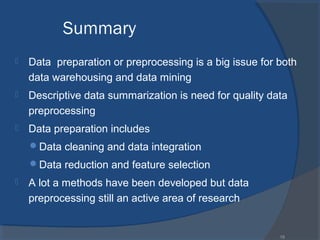Data preprocessing
- 2. Data Preprocessing Definition Why preprocess the data? Data cleaning Data integration and transformation Data reduction Summary 2
- 3. Definition Data preprocessing is a data mining technique that involves transforming raw data into an understandable format. 3
- 4. Why Data Preprocessing? Data in the real world is dirty incomplete: lacking attribute values, lacking certain attributes of interest, or containing only aggregate data ○ e.g., occupation=“ ” noisy: containing errors or outliers ○ e.g., Salary=“-10” inconsistent: containing discrepancies in codes or names ○ e.g., Age=“42” Birthday=“03/07/1997” ○ e.g., Was rating “1,2,3”, now rating “A, B, C” ○ e.g., discrepancy between duplicate records 4
- 5. Why Is Data Preprocessing Important? No quality data, no quality mining results! Quality decisions must be based on quality data ○ e.g., duplicate or missing data may cause incorrect or even misleading statistics. Data warehouse needs consistent integration of quality data Data extraction, cleaning, and transformation comprises the majority of the work of building a data warehouse 5
- 6. Major Tasks in Data Preprocessing Data cleaning Data integration Data transformation Data reduction 6
- 7. Forms of Data Preprocessing 7
- 8. Data Cleaning Importance “Data cleaning is one of the three biggest problems in data warehousing”—Ralph Kimball “Data cleaning is the number one problem in data warehousing”—DCI survey Data cleaning tasks Fill in missing values Identify outliers and smooth out noisy data Correct inconsistent data Resolve redundancy caused by data integration 8
- 9. Missing Data Data is not always available E.g., many tuples have no recorded value for several attributes, such as customer income in sales data Missing data may be due to equipment malfunction inconsistent with other recorded data and thus deleted data not entered due to misunderstanding certain data may not be considered important at the time of entry not register history or changes of the data Missing data may need to be inferred. 9
- 10. Noisy Data Noise: random error or variance in a measured variable Incorrect attribute values may due to faulty data collection instruments data entry problems data transmission problems technology limitation inconsistency in naming convention Other data problems which requires data cleaning duplicate records incomplete data inconsistent data 10
- 11. How to Handle Noisy Data? Binning first sort data and partition into (equal-frequency) bins then one can smooth by bin means, smooth by bin median, smooth by bin boundaries, etc. Regression smooth by fitting the data into regression functions Clustering detect and remove outliers Combined computer and human inspection detect suspicious values and check by human (e.g., deal with possible outliers) 11
- 12. Simple Discretization Methods: Binning Equal-width (distance) partitioning Divides the range into N intervals of equal size: uniform grid if A and B are the lowest and highest values of the attribute, the width of intervals will be: W = (B –A)/N. The most straightforward, but outliers may dominate presentation Skewed data is not handled well Equal-depth (frequency) partitioning Divides the range into N intervals, each containing approximately same number of samples Good data scaling Managing categorical attributes can be tricky 12
- 13. Binning Methods for Data Smoothing Sorted data for price (in dollars): 4, 8, 9, 15, 21, 21, 24, 25, 26, 28, 29, 34 * Partition into equal-frequency (equi-depth) bins: - Bin 1: 4, 8, 9, 15 - Bin 2: 21, 21, 24, 25 - Bin 3: 26, 28, 29, 34 * Smoothing by bin means: - Bin 1: 9, 9, 9, 9 - Bin 2: 23, 23, 23, 23 - Bin 3: 29, 29, 29, 29 * Smoothing by bin boundaries: - Bin 1: 4, 4, 4, 15 - Bin 2: 21, 21, 25, 25 - Bin 3: 26, 26, 26, 34 13
- 16. Data Integration Data integration: Combines data from multiple sources into a coherent store Schema integration: e.g., A.cust-id ≡ B.cust-# Integrate metadata from different sources Entity identification problem: Identify real world entities from multiple data sources, e.g., Bill Clinton = William Clinton Detecting and resolving data value conflicts For the same real world entity, attribute values from different sources are different Possible reasons: different representations, different scales, e.g., metric vs. British units 16
- 17. Data Transformation Smoothing: remove noise from data Aggregation: summarization, data cube construction Generalization: concept hierarchy climbing Normalization: scaled to fall within a small, specified range min-max normalization z-score normalization normalization by decimal scaling Attribute/feature construction New attributes constructed from the given ones 17
- 18. Data Reduction Why data reduction? A database/data warehouse may store terabytes of data Complex data analysis/mining may take a very long time to run on the complete data set Data reduction Obtain a reduced representation of the data set that is much smaller in volume but yet produce the same (or almost the same) analytical results Data reduction strategies Data cube aggregation: Dimensionality reduction — e.g., remove unimportant attributes Data Compression Numerosity reduction — e.g., fit data into models Discretization and concept hierarchy generation 18
- 19. Summary Data preparation or preprocessing is a big issue for both data warehousing and data mining Descriptive data summarization is need for quality data preprocessing Data preparation includes Data cleaning and data integration Data reduction and feature selection A lot a methods have been developed but data preprocessing still an active area of research 19
- 20. an Th ou y k 20
